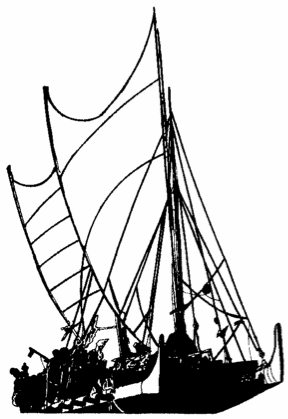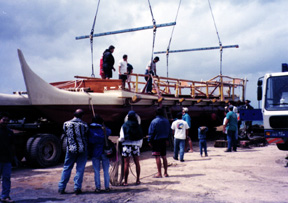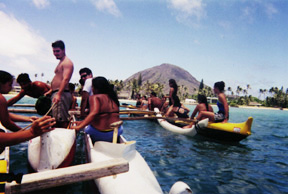PVS Newsletter / Kau (Dry Season) 1998
Restoring Hokule'a
In May of 1997, after a nine-month long State-wide Voyage, the Polynesian Voyaging Society began considering a voyage to Rapa Nui as its next major voyaging project. The question was asked, "Was Hokule'a seaworthy enough to make such a voyage-one that would take the canoe 2700 miles upwind from Hawai'i and over 10,000 miles?"
Executive director Nainoa Thompson sought the advice of a marine surveyor, who inspected the canoe and told him, "Hokule'a is getting old and you might want to consider that this canoe has sailed all it can. I cannot certify the canoe to sail more than 25 nautical miles from the main islands of Hawai'i."
Nainoa's response was "No, we can't allow that, the symbolism of this canoe is too powerful to allow it to be tied up some place. We have absolutely got to figure out what needs to be repaired and how to repair it."
So Hokule'a went into drydock for eight months, and when she came out in May, 1998, Nainoa noted: "Now the surveyor has sent in a report saying that Hokule'a is structurally stronger than when she was launched 23 years ago. That's the result of an awful lot of care on the part of a whole bunch of people. That drydock period was about renewal."
To strengthen the canoe, the inside of the hulls were fiberglassed; the lashings on the railings and port-side 'iako were redone by five Micronesians led by Mau's son Sesario Sewralur; a new forward mast step was added.
To lighten the canoe, one of the double 'iako in the middle of the canoe was removed, along with four of five stern spreaders, two navigator platforms from each side, and some waterlogged foam from one of the manu; a thinner pale wai was made and smaller high efficiency solar panels replaced the older, heavier ones. In all, around 4000 pounds was removed. Nainoa explains: "We had to get Hokule'a to sail closer to the wind for the trip to Rapa Nui; which lies 2700 miles upwind from Hawai'i. She's lighter now, and will sail higher into the wind." The work was done at Pier 60, where PVS leased space from the Friends of Hokule'a and Hawai'iloa.
Volunteers included students from PVS high school and college voyaging programs, as well as community groups across the state. The work was supervised by Bruce Blankenfeld. In May of 1998, students from WCC and UH Manoa Hawaiian Studies program took Hokule'a on its first sea trial to Moloka'i and back. The canoe performed beautifully in 25 knot winds, riding buoyantly over swells.
The canoe is now ready for the voyage to Rapa Nui, scheduled for the June 1999-January 2000. The journey will take the canoe to the Marquesas, Mangareva, Rapa Nui, the Australs, Tahiti, Rangiroa and back to Hawai'i.
To get upwind from Mangareva and find a target as small as Rapa Nui, the navigators will have to play wind shifts and use a zigzagging search strategy as they approach the island. Sail plans for the voyage are currently being developed.
Hokule'a Coming Out of Drydock
Center for Marine Sciences
In the summer of 1998, in partnership with the Department of Education and the Hawai'i Institute of Marine Biology (HIMB), University of Hawai'i at Manoa, the Polynesian Voyaging Society conducted a 5-week program in Marine Science for 25 students from across the state. In addition to covering the standard DOE Marine Science curriculum, the program had some special goals. It was designed to
– be challenging and relevant to important issues concerning Hawai'i's future;
– use the ocean and the voyaging canoe as classrooms;
– integrate school work with hand-on experiences and applications to actual places and communities in Hawai'i;
– involve the families and communities of the students and contribute to their well-being;
– explore what makes Hawai'i special and discover ways of preserving that specialness.
The following account of the program by participant Kaui Kaho'onei, a junior at Nanakuli High School, appeared in the West Coast Chronicle (September 1998):
From June 21st to July 25th the SPEBE (Summer Program for the Enhancement of Basic Education) Marine Science program joined up with the Polynesian Voyaging Society (PVS) to help teach students about marine life and navigation. Consisting of 25 juniors and seniors from various parts of the state, this program turned out to be a great success.
The first week was spent at Poka'i Bay going through the West side Jr. Lifeguard program. With instructors Matt Miller, Darryl Terukina, and District IV, the students were able to learn life guarding skills. For example, they learned different rescue techniques, underwater escapes, First Aid and CPR, and what to do to help save someone's life. Special guests Brian Keaulana, Danny Kim, Kainoa McGee, and Mark Cunningham helped out as well.
Within the week students learned the parts of a canoe and tactics of sailing using Wai'anae's very own Eala. "This week was extremely important since most of their time would be spent in the water. The students needed to be water safe," says Dennis Kawaharada, Assistant Director of the SPEBE Marine Science program.
For the next couple of weeks the students studied hard at Moku o Lo'e (Coconut Island) about marine life. Though everyone reported it to be stressful, all of them agreed to have greatly benefited from this experience. They learned to identity fish and coral, about the electromagnetic force in sharks, the effects of human impact in the ocean. Amongst the several projects they did, the teenagers were able to compare two different reefs through a series of transecting. This also gave them a chance to consider marine biology as a career.
SPEBE Students Paddling Out into Maunalua Bay to Transect a Reef
Under the direction of master navigator, Nainoa Thompson, and PVS instructors, Pi'ikea Miller, and Kamaki Worthington, the fourth week was filled with fun sailing and camping activities. The group did a series of five separate sails along the leeward coast and south end of O'ahu on the Hokule'a. The first sail began at Honolulu Harbor heading to Maunalua Bay in Hawaii Kai. From that point they sailed to the Ala Wai Harbor, then to Poka'i Bay, on to Keawa'ula, andd then back to Poka'i Bay. The students could all feel the love for Hokule'a by the people among the many communities, especially into anti out of Poka'i Bay and Keawa'ula. The people looked stoked to see this great voyaging masterpiece. "It felt like only the privileged belonged on the canoe, because everyone stopped what they were doing and just stood still and watched us," mentioned Ceiva Boon, one of the SPEBE students.
During these voyages the teens learned about the wind and ocean currents, how to sail and tack in the wind, how to tie different types of knots, and most of all, the importance of teamwork. It taught them how to navigate the old Hawaiian way- with only the stars, moon, and certain land-marks. While the canoe was anchored in Maunalua Bay and Poka'i Bay they also had the opportunity to sleep on board over night.
The students then took a three-day trip to Moloka'i during the final week. While camping at Mo'omomi Beach Park, they learned of ancient cultural sites, native endangered plants, as well as how ancient Hawaiians used pohaku to draw petroglyphs and make konane boards. Their activities also included hikes to the Kalaupapa look out and up the Halawa 'auwai to help rebuild a dam.
The five weeks came to an end with a pa'ina at Kaiser High School. The SPEBE Marine Science teens used this time to share the mana'o they gained from the program with their family and friends. There was much reminiscing throughout the night by the new SPEBE "family." Along with earning a high school science credit, students also received a certificate of completion and, all but one, were certified as lifeguards and CPR rescuers. Nainoa Thompson gave an emotional speech that night saying, "You will always preserve the things you love for your future kids to have." And everyone in the room was in total agreement; we need to "Malama i ka 'aina a me ke kai."
Much Mahalo goes out to Dennis Kawaharada, Nainoa Thompson, Pi'ikea Miller, Dennis Gouveia, Kamaki Worthington, Aunty Kaui, all the interns and everyone else who helped out. Thanks to you all the ocean was truly our classroom!
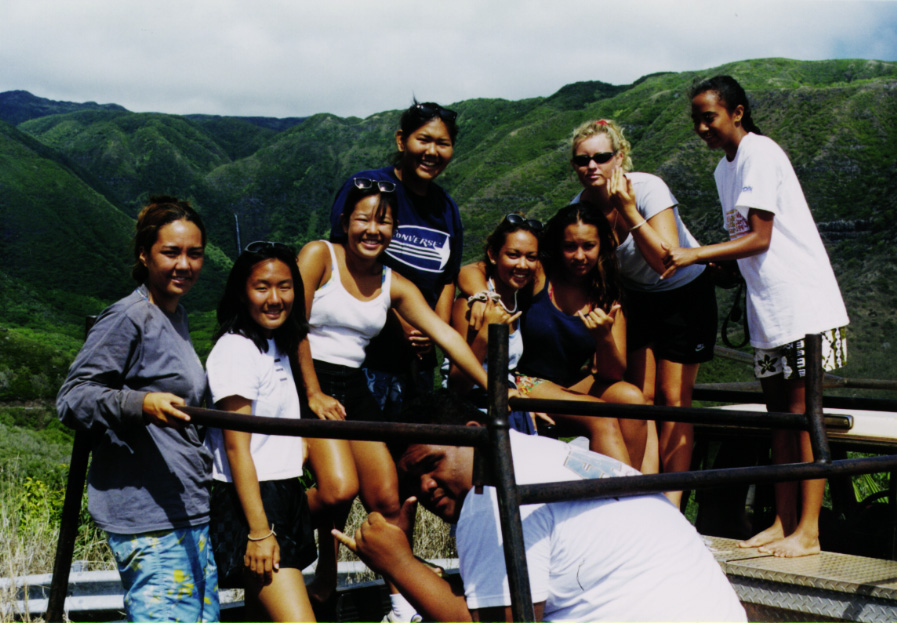
SPEBE Students above Halawa Valley; author Kaho'onei is on the right.
PVS wishes to thank all who helped out with the SPEBE Program Kamaki Kanahele and Kauila Clark for welcoming the students to Wai'anae; Dennis Gouveia, Mel Pu'u, Brian Keaulana, and the Westside Hawaiian Lifeguard 'Ohana for sharing their knowledge of the Wai'anae Coast; Glenn Pang, City and County Life Guard for running the lifeguarding certification program; Gordon Grau, Malia Chow, and Greta Aeby of the HIMB for the marine biology curriculum; Sam Gon of the Nature Conservancy for his talk on ahupua'a; Paul Reppun and the Waiahole farmers; 'Aulani Wilhelm, Dave Gulko, and Joanne Kushima of the DLNR; Matt Poepoe and Kekama for teaching the students about Mo'omomi; Les of Halawa, Moloka'i; Patty Lee and Rick Lumpkin of the School of Ocean and Earth Sciences and Technology (SOEST), UH Manoa; Kamuela Chun, Director of the Native Hawaiian Programs for the Community Colleges, who taught the students a name chant for Hokule'a; Lilikala Kame'eleihiwa for allowing us to use a classroom at the Center for Hawaiian Studies; interns and PVS crew members Russell Amimoto, Shantell Ching, Rob Griffin, Terry Hee, Camille Kalama, Heather Mendez, Ka'iulani Murphy, Sarah Parker, Ryan Wong; dorm managers Michelle Kapana-Baird and Gordon Mau, and many others who helped to enhance the education of the students. They were appreciated by all.
Student comments:
"This program has taught me so much-stars, oceanography, teamwork-the ocean has truly been my classroom this summer.
"The only way to lean anything is to just go out and do it yourself and that's what we did. Everything was totally hands on and even though it was tough, it was the best!
"I look at things differently now. I look at the ocean and I don't just see a body of water, I see a magical place.I gained a lot of knowledge that I'm able to take with me to the future. And the funny thing is that I had fun doing it. I wanted to learn, I was eager to learn. I recall hearing words like "ohhhh" and "wow." We were interested. Learning was something that we wanted to do. It's not like school where you learn something and forget it a week later. It's something you'll always remember because you're able to apply it to life.
"Helping out the communities we visited made me feel good; we let adults know that there are some kids who care and want to help."
"I came to the program for the science part but I found myself enjoying the other aspects of it more. This helped me to get a broader view and more respect and appreciation of our oceans. On a scale of 1-10, I give it a perfect 10."
"The whole experience had a lasting effect on me. During the first week of life-guarding, we were doing board relays and there was someone who was still finishing when everyone else was done. I know that person was probably shame knowing all eyes were on her. Without hesitation, the whole group got up and joined her in the water. As we finished all together I knew that we had already begun to think of each as family."
"The mixture of science and culture made me even more aware of why Hawai'i is so unique and why we need to do all we can to protect and preserve it. I have made so many friends. The mixture of personalities and values was a challenge worth overcoming to make these lasting friendships. This program and summer will always last in my heart and memories. This truly was the best summer I ever had!"
A Gift from the Northwest
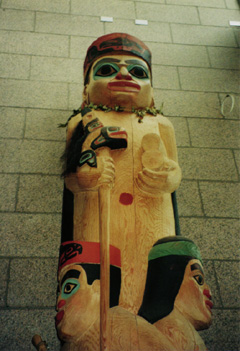 On March 14, 1998, the Sealaska Corporation presented the Polynesian Voyaging Society with a 14-foot tall Alaskan red cedar house post at a ceremony on the grounds of the Bishop Museum. The gift commemorates the bond that has developed between the native peoples of Southeastern Alaska and Hawai'i.
On March 14, 1998, the Sealaska Corporation presented the Polynesian Voyaging Society with a 14-foot tall Alaskan red cedar house post at a ceremony on the grounds of the Bishop Museum. The gift commemorates the bond that has developed between the native peoples of Southeastern Alaska and Hawai'i.
From 1991-1993, the hulls of the voyaging canoe Hawai'iloa were built from Sitka spruce logs donated to the Polynesian Voyaging Society by Sealaska Corporation. In honor of that generous gift, Hawai'iloa traveled throughout Southeast Alaska in the summer of 1995. Strong friendships were forged during that voyage-friendships symbolized by this house post.
Traditionally, a house post is raised at the entrance of a dwelling to identify the occupants.
The new house post will be temporarily placed at the Bishop Museum; plans call for permanent placement in a halau for voyaging canoes at a site somewhere on O'ahu. An identical house post will be raised in Juneau this summer.
Both house posts were carved by Nathan Jackson, a world-renown Tlingit wood-artist from Ketchikan. It was Jackson's late uncle, Judson Brown, who helped foster the connections between Hawai'i and Aaska. Jackson was on hand at the presentation ceremonies.
